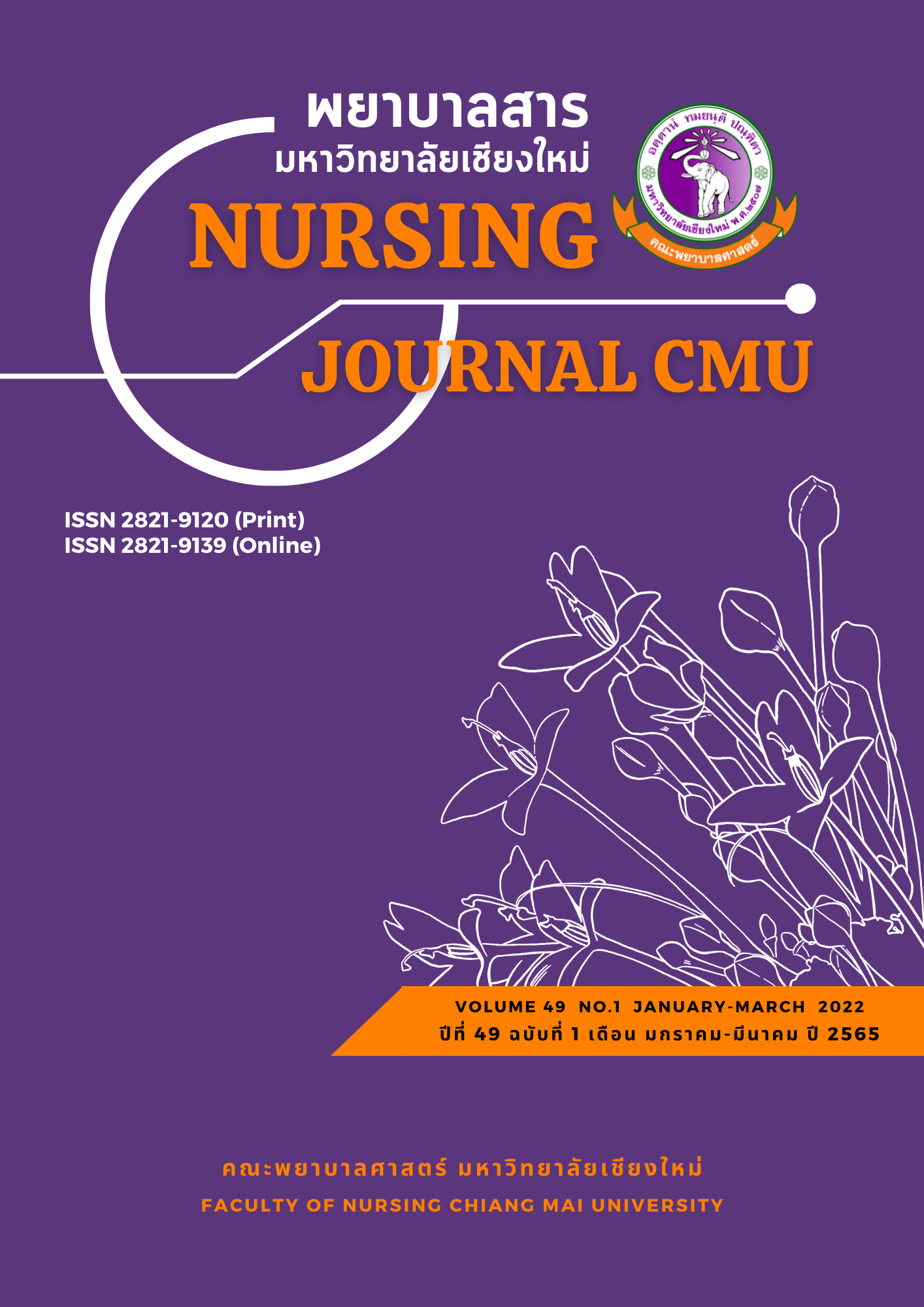Nursing and Caring for a Patient with a Liver Abscess and Percutaneous Drainage of a Liver Abscess
Keywords:
Liver abscess, Percutaneous drainage, Complication, Nursing care, Self-careAbstract
A Liver abscesses is defined as a purulent infection in the liver. It is caused by liver injury, intra-abdominal infections and intra-abdominal infections spreading from the portal vein.The main causes of inflammation of the liver abscess include biliary tract disease gallstones, cancer, and congenital abnormalities.Its complications can be fatal from the spreadingof infection to bloodsgtream. Guidelines for the treatment of liver abscess include antibiotics, surgery and percutaneous drainage of a liver abscess. Drainage is done with the use of special examination tools such as ultrasound and CT scan by interting the drain hose in the correct position. It is the treatment of choice and is popular nowadays. However, this procedure, if lacking proper preparation, may cause complications.
The purpose of this paper is to review the pathology of liver abscess, the indications and nursing guidelines for percutaneous drainage, as well as preparation of the patient before, during and after the procedure. Follwed by the prevention of complications after percutaneous drainage, including self-care after intubation.
References
Anesi, J. A., & Gluckman, S. (2015). Amebic liver abscess. Clinical liver disease, 6(2), 41–43. https://doi.org/10.1002/cld.488
Abbas, M. T., Khan, F. Y., Muhsin, S. A., Al-Dehwe, B., Abukamar, M., & Elzouki, A. N. (2014). Epidemiology, clinical features and outcome of liver abscess: A single reference center experience in Qatar. Oman Medical Journal, 29(4), 260-263. doi:10.5001/omj.2014.69
Czerwonko, M. E., Huespe, P., Bertone, S., Pellegrini, P., Mazza, O., Pekolj, J., Santibañes, E., … Santibañes, M. (2016). Pyogenic liver abscess: Current status and predictive factors for recurrence and mortality of first episodes. The Official Journal of the International Hepato Pancreato Biliary Association, 18(12), 1023-1030. doi:10.1016/j.hpb.2016.09.001
Davis, J., Mcdonald, M. (2020). Pyogenic liver abscess. Uptodate. Retrieve form https://www.uptodate.com/contents/pyogenic-liver-abscess
Dzib Calan, E., Larracilla Salazar, I., & Morales Pérez, J. I. (2019). A giant liver abscess due to fasciola hepatica infection. Revista Espanola de Enfermedades Digestivas, 111(10), 815-816. doi:10.17235/reed.2019.6136/2018
Fujii, M., Shirakawa, T., Shime, N., & Kawabata, Y. (2020). Successful treatment of extensive spinal epidural abscess with fluoroscopy-guided percutaneous drainage: A case report. Journal of Anesthesia Clinical Reports, 6(1), 4. doi:10.1186/s40981-020-0309-z
Haider, S. J., Tarulli, M., McNulty, N. J., & Hoffer, E. K. (2017). Liver abscesses: Factors that influence outcome of percutaneous drainage. American Journal of Roentgenology, 209(1), 205-213. doi:10.2214/ajr.16.17713
Harclerode, T. P., & Gnugnoli, D. M. (2021). Percutaneous abscess drainage. Treasure island, FL: Statpearls.
Lo, J. Z., Leow, J. J., Ng, P. L., Lee, H. Q., Mohd Noor, N. A., Low, J. K., … Woon, W. W. L. (2015). Predictors of therapy failure in a series of 741 adult pyogenic liver abscesses. Journal of Hepato-Biliary-Pancreatic Sciences, 22(2), 156-165. doi:10.1002/jhbp.174
Mavilia, M. G., Molina, M., & Wu, G. Y. (2016). The evolving nature of hepatic abscess: A review. Journal of Clinical and Translational Hepatology, 4(2), 158-168. doi:10.14218/jcth.2016.00004
Mendez-Pastor, A., & Garcia-Henriquez, N. (2020). Complicated diverticulitis. Diseases of the Colon & Rectum, 63(1), 26-28.
Mischnik, A., Kern, W. V., & Thimme, R. (2017). Pyogenic liver abscess: Changes of organisms and consequences for diagnosis and therapy. Deutsche Medizinische Wochenschrift, 142(14), 1067-1074. doi:10.1055/s-0043-100540
National Health Service. (2019). Percutaneous drainage. National Health Service. Retrieve form https://www.nhs.uk/conditions/abscess/treatment/(wPCD4(1)
Pithawa, A. K. (2007). Sleisenger and Fordtran's gastrointestinal and liver disease: Pathophysiology, diagnosis, management. Medical Journal, Armed Forces India, 63(2), 205-205. doi:10.1016/S0377-1237(07)80085-2
Prueksapanich. P, (2019). Ultrasound-guided liver biopsy and drainage. Thai Journal Hepatology, 2(1),18-26.
Poovorawan, K., Pan-Ngum, W., Soonthornworasiri, N., Kulrat, C., Kittitrakul, C., Wilairatana, P., … Phaosawasdi, K. (2016). Burden of liver abscess and survival risk score in Thailand: A population-based study. American Journal of Tropical Medicine and Hygiene, 95(3), 683-688. doi:10.4269/ajtmh.16-0228
Pornthep, S. (2016). Liver abscess. Medicnote. Retrieve form https://sites.google.com/site/medicnote/infection/liver-abscess
Shavrina, N. V., Ermolov, A. S., Yartsev, P. A., Kirsanov, I. I., Khamidova, L. T., Oleynik, M. G., & Tarasov, S. A. (2019). Ultrasound in the diagnosis and treatment of abdominal abscesses. Journal Khirurgiia Mosk, 2019(11), 29-36. doi:10.17116/hirurgia201911129
Singh, P., Tapasvi, C. Kaur, R., Aggarwal, S., Nagpal, N., & Kaur, R. (2019). Prospective randomized comparison of ultrasound guided percutaneous catheter drainage and percutaneous needle aspiration for the treatment of liver abscess. Journal of Medical Sciences, 39(2), 67-73. doi: 10.4103/jmedsci.jmedsci_74_18
Singh, S., Chaudhary, P., Saxena, N., Khandelwal, S., Poddar, D. D., & Biswal, U. C. (2013). Treatment of liver abscess: Prospective randomized comparison of catheter drainage and needle aspiration. Annals of Gastroenterology, 26(4), 332-339.
Stacy Sampson, D. O. (2018). Pyogenic liver abscess, health line. Retrieve form https://www.healthline.com/health/pyogenic-liver-abscess
Stan-Ilie, M., Plotogea, O. M., Rinja, E., Sandru, V., Butuc, A., Gheorghe, G., … Constantinescu, G. (2021). Ultrasound-guided percutaneous drainage of abdominal collections an analysis over 5 years. Gastroenterol Insights, 12, 366–375.
doi: org/10.3390/ gastroent12030035
Suthichaimongkol, T. (2021) Liver abscess caused by a bacterial infection. Thai Association for the Study of the Liver. Retrieve form https://thasl.org/liver-abscess/
Teach, R., (2014). Percutaneous drainage of liver abscess, medical imaging guided minimal invasive procedures. Retrieve form http://drrattawachteach.blogspot.com/2014/08/percutaneous-drainage-of-liver-abscess.html
Downloads
Published
How to Cite
Issue
Section
License
Copyright (c) 2022 Nursing Journal

This work is licensed under a Creative Commons Attribution-NonCommercial-NoDerivatives 4.0 International License.
บทความที่ได้รับการตีพิมพ์เป็นลิขสิทธิ์ของวารสารพยาบาลสาร
ข้อความที่ปรากฏในบทความแต่ละเรื่องในวารสารวิชาการเล่มนี้เป็นความคิดเห็นส่วนตัวของผู้เขียนแต่ละท่านไม่เกี่ยวข้องกับมหาวิทยาลัยเชียงใหม่ และคณาจารย์ท่านอื่นๆในมหาวิทยาลัยฯ แต่อย่างใด ความรับผิดชอบองค์ประกอบทั้งหมดของบทความแต่ละเรื่องเป็นของผู้เขียนแต่ละท่าน หากมีความผิดพลาดใด ๆ ผู้เขียนแต่ละท่านจะรับผิดชอบบทความของตนเองแต่ผู้เดียว






